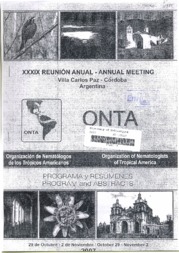Diversity of Meloidogyne exigua (Tylenchida: Meloidogynidae) populations from coffee and rubber tree.
Diversity of Meloidogyne exigua (Tylenchida: Meloidogynidae) populations from coffee and rubber tree.
Author(s): MUNIZ, M. F. S.; CAMPOS, V. P.; CASTAGNONE-SERENO, P.; CASTRO, J. M. da C. e; ALMEIDA, M. R. A.; CARNEIRO, R. M. D. G.
Summary: Isozymes (esterase and malate desydrogenase), SCAR and RAPD-PCR were compared for populations of three races of Meloidogyne exigua, collected in coffee-producing areas in Brazil, Bolivia, and Costa Rica, and for one Brazilian population from rubber tree. This study revealed four esterase phenotypes (E1, E2, E2a, E3) and three malate desydrogenase phenotypes (N1, N1a, N2) for M. exigua populations. The most common multienzyme phenotype was E2N1. The enzymaticphenotypes do not separate M. exigua races. Sixteen populations of M. exigua were tested using SCAR primers ex-D15F/R that allowed the identification of all M exigua populations. Phylogenetic analyses showed high intraspecific polymorphism (24.6-57.8%) for sixteen M. exigua population. However, all populations clustered together with 100% of bootstrap showing the consistency of species identification. In addition, the RAPD markers produced were consistent with other approaches (isozyme phenotypes and SCAR). *Scholarship FAPEAL.
Publication year: 2007
Types of publication: Abstract in annals or event proceedings
Unit: Embrapa Semi-arid Region
Keywords: Café, Coffee, Meloidogyne Exigua, Planta produtora de latex, População de Planta
Observation
Some of Embrapa's publications are published as ePub files. To read them, use or download one of the following free software options to your computer or mobile device. Android: Google Play Books; IOS: iBooks; Windows and Linux: Calibre.
Access other publications
Access the Agricultural Research Database (BDPA) to consult Embrapa's full library collection and records.
Visit Embrapa Bookstore to purchase books and other publications sold by Embrapa.

